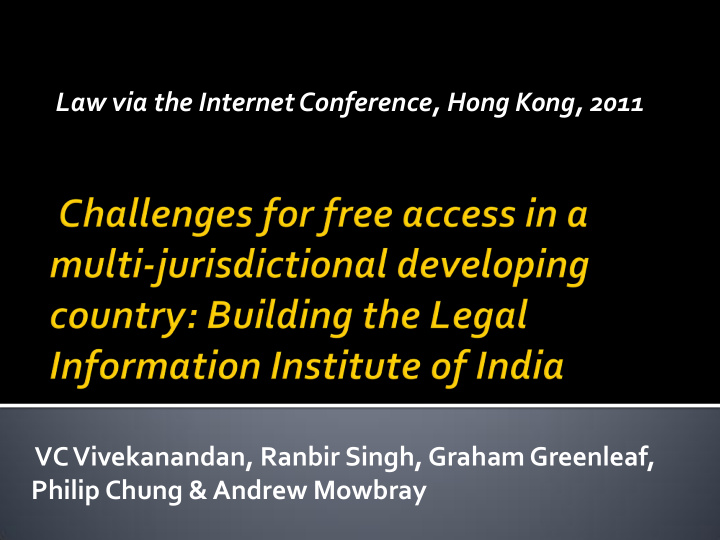



Law via the Internet Conference, Hong Kong, 2011 VC Vivekanandan, Ranbir Singh, Graham Greenleaf, Philip Chung & Andrew Mowbray
UNDERSTANDING THE INDIAN LEGAL MATRIX BIRTH OF LII OF INDIA EVOLUTION STAGES CONCLUSIONS
36 JURISDICTIONS 1 UNION GOVERNMENT 28 STATES 7 TERRITORIES LAWS DATING BACK TO 1857 STILL OPERATIONAL SUPREME COURT DECISIONS AROUND 28000 ALL COURTS PUT TOGATHER HALF MILLION JUDGEMENTS IN LAST DECADE
63 YEARS OF DEMOCRACY WITH ABOVE 80% VOTER TURN AROUND A WELL DRAFTED CONSTITUTION AND AN ACTIVE JUDICIARY RECOGNIZED WORLD OVER AS THE INFORMATION TECHNOLOGY FRONT RUNNER WORLD’S HUB FOR BUSINESS AND IT OURSOURCING
INTERNAL LEGAL DOCUMENTATION SCATTERED & DISORGANIZED THE PRIVATE PLAYERS CATER TO FEW AFFORDABLE CLIENTS INDIVIDUALS, SMALLER INSTITUTIONS DO NOT HAVE CREDIBLE AND FREE ACCESS
INDIA CODE BY NATIONAL INFORMATICS CENTRE – A WELL INTENDED EFFORT LACKS CONSOLIDATION, UPDATION OF AMENDMENTS AND OUT OF DATE IN TERMS OF SEARCH STANDARDS THE RESULT IS DEPENDENCE ON PRINT MODE SUPPLIED BY SMALL ENTREPRUENERS Indian Treaties since 1947 are literally difficult to get online
Since 1988 a new breed of Indian law schools have emerged changing the landscape of legal education They do produce legal resources by way of print journals yet not networked in a meaningful way
(1) Laws are by the people, for the people and of the people, and hence are the property of the society in general; (2) The quality of democracy is directly proportional to the awareness and access of the laws that govern them; and (3) If information, particularly legal information, is the oxygen of the body politic, it has to be breathed freely.
The initial efforts for Legal Information Movement in India started in 1999 with AustLII represented by Prof. Graham at National Law School Bangalore with Prof.Vivekanandan but was a non starter The threads were picked up in 2007 again by the efforts of Prof.Graham and this time Prof.Ranbir Singh and Prof.Vivekanandan at NALSAR collaborated to move it forward
AustLII’s application to AusAID (Australia’s foreign aid agency) for funding under its Public Sector Linkages Program (PSLP) to develop free access to law in South Asia, and funding of A$275,000 was eventually granted in late 2009. Database development started at AustLII, and the partners held their first meeting in New Delhi in January 2010
March 9 of 2011 saw the formal launch of LII of India by Hon’ble Law Minister of India – Dr.Veerapa Moily in Delhi with satellite launches at Hyderabad, Bangalore and Kolkata Eight partners of AustLII, NALSAR- Hyderabad, NLU-Delhi,NLS-Bangalore NUJS-Kolkata, GNLU-Ahmedabad, TNDALU- Chennai, RGNLU- Patiala
Uses AustLII-developed open source Sino search engine6 and tools on a Linux platform. Enables boolean and proximity searching; gives flexible displays of results (by relevance, by date, by database and by citation frequency). Uses LawCite citatator
Currently running from AustLII India server Mirror server to be positioned at NALSAR Hyderabad by the year end. Geographic distribution of workload among partner Law Schools
LII of India to be transformed as a Society with appropriate Advisory committee Funding methods by way of voluntary contribution is under process AustLII to lend technical supports and to be part of the Advisory Board
Early identification by an established LII of local partner organisations with substantial non-commercial reasons to wish to establish free access to law, and their involvement in all stages of the project. • Adopting a broad approach to content acquisition, including all ‘five pillars’ of free access content, so as to create a LII with the richest possible search results and serving the broadest audience. • Utilisation of available online resources to build an initial system quickly, with impact. • Active collaboration by local partners to source data previously not available online. • Continuing involvement by the established LII in technical assistance, and possibly in governance. • Development of a funding model relying on diverse sources of funding.
Thank you for your time and look forward to inputs and feedback from other members of LII family www.liiofindia.org
Recommend
More recommend